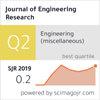咖啡羊皮纸壳灰陶瓷砖物理力学性能的优化
IF 0.9
4区 工程技术
Q3 ENGINEERING, MULTIDISCIPLINARY
引用次数: 0
摘要
咖啡羊皮纸壳灰(CPHA)是一种咖啡加工产品,被发现具有与长石相似的助熔剂氧化物。CPHA通过燃烧咖啡羊皮纸在工业中大量生产,以产生用于干燥目的的能量。pha通常被弃置于堆填区和露天场地,对环境和生态系统造成污染。本文采用响应面法(RSM)对长石中CPHA含量在10% ~ 90%范围内、烧成温度在800 ~ 1200℃范围内的陶瓷砖体进行了优化。响应变量为线性收缩率(LS)、吸水率(WA)和抗弯强度(FS)。瓷器中的其他材料保持在10%的沙子,20%的球粘土和40%的高岭土。混合料在40 MPa下干压,并以34℃/min的速率烧制至各自的峰值温度。得到的最佳工艺条件为长石中CPHA含量为10%,烧成温度为1197℃。验证实验:LS为8.15%,WA为0.11%,FS为38.32 MPa。这些值与RSM的最佳响应一致,因此证实了所开发的预测模型的准确性。测试值在1SO 13006:2018对陶瓷地砖规定的范围内。这些发现表明,CPHA可以作为生产陶瓷地砖的原料。在陶瓷生产中采用CPHA有助于降低维护垃圾填埋场的成本。本文章由计算机程序翻译,如有差异,请以英文原文为准。
Optimization of physical and mechanical properties of porcelain tiles from coffee parchment husk ash
Coffee parchment husk ash (CPHA), a product from coffee processing was found to have similar fluxing oxides as are found in feldspars. CPHA is produced in large quantities through the combustion of coffee parchment in industries to produce energy for drying purposes. CPHA is commonly disposed of in landfills and open fields, causing pollution to the environment and ecosystems. In this work, response surface methodology (RSM) was used for optimization of porcelain tile bodies in which the portion of CPHA in feldspar was varied from 10 to 90 wt% and firing temperature from 800 to 1200 ℃. The response variables were linear shrinkage (LS), water absorption (WA), and flexural strength (FS). Other materials in the porcelain were maintained at 10 wt% sand, 20 wt% ball clay, and 40 wt% kaolin. Mixed proportions were dry pressed at 40 MPa and fired to respective peak temperatures at a rate of 34 ℃/min. The optimum conditions obtained were 10% of CPHA in feldspar and 1197 ℃ firing temperature. Validation experiments presented LS 8.15%, WA 0.11%, and FS 38.32 MPa. These values agree with optimum responses from RSM and therefore confirm the accuracy of developed prediction models. The test values lie within the range specified by 1SO 13006:2018 for porcelain floor tiles. These findings demonstrate that CPHA can be used as a raw material for production of porcelain floor tiles. Adoption of CPHA in ceramic production can contribute to reduction in the costs of maintaining landfills.
求助全文
通过发布文献求助,成功后即可免费获取论文全文。
去求助
来源期刊

Journal of Engineering Research
ENGINEERING, MULTIDISCIPLINARY-
CiteScore
1.60
自引率
10.00%
发文量
181
审稿时长
20 weeks
期刊介绍:
Journal of Engineering Research (JER) is a international, peer reviewed journal which publishes full length original research papers, reviews, case studies related to all areas of Engineering such as: Civil, Mechanical, Industrial, Electrical, Computer, Chemical, Petroleum, Aerospace, Architectural, Biomedical, Coastal, Environmental, Marine & Ocean, Metallurgical & Materials, software, Surveying, Systems and Manufacturing Engineering. In particular, JER focuses on innovative approaches and methods that contribute to solving the environmental and manufacturing problems, which exist primarily in the Arabian Gulf region and the Middle East countries. Kuwait University used to publish the Journal "Kuwait Journal of Science and Engineering" (ISSN: 1024-8684), which included Science and Engineering articles since 1974. In 2011 the decision was taken to split KJSE into two independent Journals - "Journal of Engineering Research "(JER) and "Kuwait Journal of Science" (KJS).
 求助内容:
求助内容: 应助结果提醒方式:
应助结果提醒方式:


